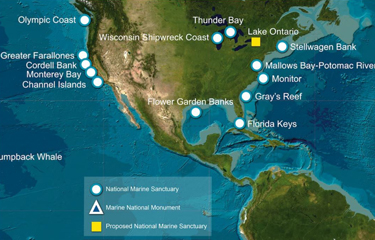Huffman, Graves reestablish congressional marine sanctuary caucus

In advance of next year’s golden anniversary for the National Marine Sanctuaries Act, two congressmen representing key fishery regions have joined forces to relaunch a bipartisan caucus to promote and continue protecting habitats crucial for coastal economies.
U.S. Reps. Jared Huffman (D-California) and Garret Graves (R-Louisiana) will serve as co-chairs for the reestablished caucus, which according to the National Marine Sanctuary Foundation was first formed 15 years ago. The foundation noted that 30 members have already signed up to join the group.
In a joint release, the caucus leaders said marine sanctuaries generate USD 8 billion in economic impact (EUR 6.9 billion). Besides fishing, sanctuaries also boost economies by attracting tourists, visitors enjoying recreational activities, and scientific research.
“Just off Louisiana’s coast, the coral reefs and algal sponges of the Flower Garden Banks National Marine Sanctuary demonstrate how marine conservation can support these activities,” Graves said. “This caucus expands on these conservation efforts and is a great example of how an additional educational opportunity can lead to tourists and anglers getting more opportunities to enjoy fishing in south Louisiana.”
According to NOAA, there are 13 freshwater and saltwater national marine sanctuaries, created through a processes established under the 1972 Sanctuaries Act. The Office of National Marine Sanctuaries has oversight over more than 600,000 square miles of protected area located off both coasts and in the Great Lakes.
Huffman has two marine sanctuaries in his district, Greater Farallones and Cordell Bank.
“National Marine Sanctuaries are treasured areas that protect natural, historical, and cultural places in the oceans and Great Lakes,” Huffman said. “These spectacular underwater parks encompass a broad range of breathtaking natural features, including kelp forests, rocky and coral reefs, beaches, freshwater lakes, deep-sea canyons, islands, and more.”
National Marine Sanctuary Foundation President and CEO Kris Sarri said in a statement the caucus will help raise more awareness about them and the purpose they serve.
“National marine sanctuaries and monuments are our essential network of protected waters owned by every American,” Sarri said. “They sustain miraculous species, coastal communities, and our shared heritage.”
National sanctuaries are like national marine monuments, but the two programs were established through different laws, which means they are established through separate legal mechanisms.
Under the National Marine Sanctuaries Act, either NOAA or Congress can establish sanctuaries. The federal agency has established 10 of the sanctuaries working with local and federal government leaders, key industry stakeholders, and the public before making a final decision.
Marine monuments, such as the recently created Northeast Canyons and Seamounts Marine National Monument and Papahānaumokuākea Marine National Monument, have recently be created via the Antiquities Act, a law giving the president the authority to preserve landmarks and other areas of historical or scientific significance.
Image courtesy of NOAA Office of National Marine Sanctuaries






Share